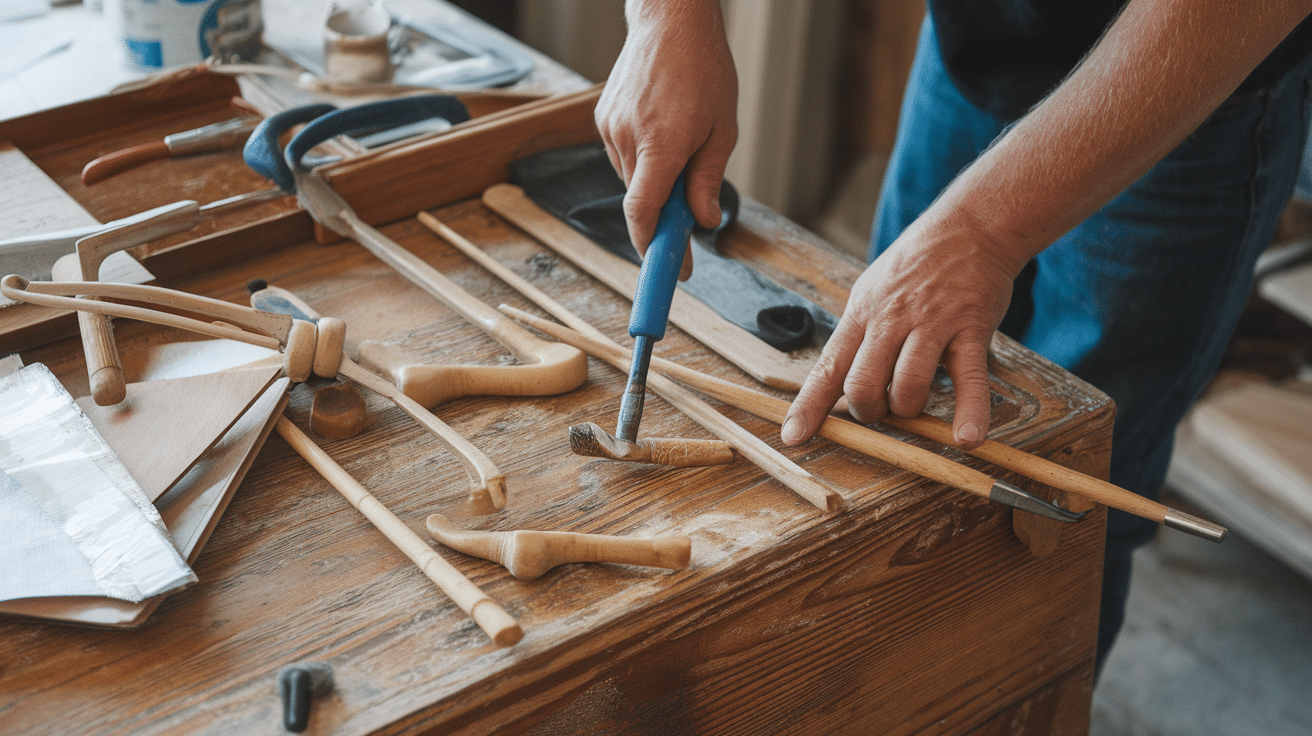Find the thrill of change! That overlooked wooden treasure gathering dust might be your next unexpected masterpiece.
Whether it’s a sleek mid-century dresser with smart lines or a classic table with rich grain patterns, the potential for beauty lies beneath tired surfaces.
Forget intimidating projects that require specialized skills—this guide reveals how anyone can revive wooden gems using simple techniques and basic tools. No workshop is needed, just a weekend and some patience.
Imagine running your hands across silky-smooth walnut that gleams with natural warmth. Picture friends asking, “Where did you find this gorgeous piece?” and smiling as you reveal, “I brought it back to life myself.”
Ready to unlock the hidden beauty in overlooked wooden treasures? Your refurbishing adventure starts now!
Choosing the Right Piece to Refurbish Your Furniture
The key to a satisfying first restoration is selecting the right piece of furniture. Look for items that are structurally sound with good “bones” but may have cosmetically tired surfaces.
Mid-century pieces like walnut dressers with clean lines and minimal ornamentation make ideal first projects because their simple designs are forgiving for beginners.
You should avoid pieces with significant structural damage, extensive veneer loss, or complex carvings until you’ve gained more experience.
The ideal candidate is something you could technically use after a good cleaning but would truly shine with proper restoration.
Many wonderful projects come from family heirlooms or second-hand shops rather than extreme transformations.
Focus on quality wood pieces with good craftsmanship. These will respond best to your efforts and provide the most satisfying results.
Remember, the goal is to enhance the wood’s natural beauty while preserving the character that comes from decades of loving use.
Step-by-Step Refurbishing Guide
Tools and Materials
| Tools | Materials |
|---|---|
| Metal scraper | Hardwax oil finish |
| Sandpaper (150, 220, 320, 400 grit) | Furniture wax |
| Sanding block | Drawer slide compound |
| Clean rags | Optional: Wood stain |
| Screwdriver set | Optional: Wood filler |
| Protective gloves | Optional: Replacement hardware |
| Dust mask | |
| Optional: Electric sander |
Step 1: Assess Your Furniture
Check drawer order by looking for numbers on backs or examining grain patterns across drawer fronts. Properly ordered drawers fit best and look most cohesive.
Test each drawer for smooth sliding and look for cracked plastic guides that may need replacement.
Step 2: Removing the Old Finish
Scraping is usually the safest and most effective method for veneer furniture. Hold the scraper at a 45-degree angle and apply gentle pressure, working with the grain.
For solid wood parts like legs, you can use sandpaper starting with 80 grit. Always be cautious with veneer surfaces, as they may be very thin.
Step 3: The Sanding Process
After scraping, start with 150-grit sandpaper and work up to finer grits (220, then 320) for a smooth surface. Always sand in the direction of the grain, using lighter pressure on the veneer.
Wipe surfaces clean between grits with a tack cloth to prevent scratches. Don’t skip grits – the progression creates the smoothest finish.
Step 4: Addressing Imperfections
For deep scratches, apply steam with a damp cloth and a warm iron for about 30 seconds. This raises wood fibers, making scratches less visible. Let dry, then sand lightly.
Water rings usually disappear with thorough sanding. Small dents can be treated with the same steaming method used for scratches.
Step 5: Drawer Repairs and Adjustments
Add small wooden or plastic guides to center drawers that move too much from side to side. Replace any cracked plastic drawer guides – they’re inexpensive and improve functionality.
Apply drawer slide compound to all wood-on-wood contact points to reduce friction. Make sure drawers sit level and handles align properly.
Step 6: Staining (Optional)
Staining enhances the wood grain and helps create a cohesive look if your piece uses different wood types. Choose a complementary color – for walnut, “nutmeg” works beautifully.
Apply with a clean cloth in the direction of the grain. Wipe off excess after 5-10 minutes and allow to dry completely before finishing.
Step 7: Applying the Finish
Hardwax oil provides excellent protection while preserving a natural look. Wipe it with a clean cloth, following the grain direction.
After the first coat dries (4-6 hours), lightly sand with 400-grit paper, wipe clean, and apply a second coat. Add furniture wax for a subtle shine.
Step 8: Final Assembly
Reattach all hardware and place drawers back in their proper positions. To prevent damage, keep your restored piece away from direct sunlight and heating vents.
The entire project typically takes about three days, with most time spent sanding and waiting for finishes to dry. The transformation is well worth the effort!
Video Tutorial
Check out this YouTube video for a detailed step-by-step Tutorial by MCM redo
Approximate Costs
| Item Category | Approximate Cost |
|---|---|
| Basic tools | $50–100 |
| Essential materials | $40–80 |
| Optional items | $30–70 |
| Total budget | $90–180 (depending on what you already have) |
Furniture Refurbishment Tips
- Ventilation Matters – Work in well-ventilated spaces to avoid harmful fumes. Use fans, open windows, or work outdoors when possible.
- Test First – Always test products on hidden areas before applying to visible surfaces to avoid unexpected reactions.
- Thin Coats Win – Apply multiple thin coats rather than one thick layer for better protection and a more professional finish.
- Preserve Character – Not every scratch needs fixing—some wear adds authentic vintage appeal and tells the piece’s story.
- Be Patient – Never rush drying times between steps. Wait longer than recommended in humid or cool conditions.
- Maintain Sandpaper- To keep sandpaper clean, tap it against a hard surface or use compressed air to prevent scratching.
- Document Everything – Take before, during, and after photos to track progress and create a reference for future projects.
Alternate Ideas for Wood Furniture Transformation
Upcycling Approaches
- Two-Tone Finish: Paint the frame while keeping the top in natural wood for a modern contrast
- Decoupage Accents: Apply decorative paper to drawer fronts or side panels for artistic flair
- Geometric Patterns: Use painter’s tape to create bold geometric designs with contrasting colors
- Chalk Paint Transformation: Skip the extensive sanding by using chalk paint for a vintage, distressed look
Alternative Techniques
- Cerusing: Highlight the wood grain by rubbing white wax into open-grain woods like oak
- Color Washing: Apply a diluted paint layer that allows the wood grain to show through for a subtle tint
- Wood Burning: Add decorative patterns to plain wooden surfaces with a pyrography tool
- Milk Paint Finish: Create an authentic antique appearance with milk paint and strategic distressing
Sustainable Approaches
- Natural Finishes: Use plant-based oils like tung oil or beeswax for eco-friendly protection
- Hardware Upcycling: Create unique drawer pulls from vintage silverware, leather straps, or rope
- Patchwork Repair: Use contrasting wood pieces to fill damaged areas as a design feature
- Fabric Integration: Replace wooden panels with stretched fabric for texture and color
Quick Transformations (When Time Is Limited)
- Hardware Swap: Simply changing knobs and pulls can dramatically update a piece’s appearance
- Colored Wax: Apply tinted furniture wax for subtle color that enhances rather than covers the wood grain
- Edge Painting: Paint only the edges of drawers or shelves for a pop of color with minimal effort
- Contact Paper Lining: Transform drawer interiors or cabinet backs with decorative adhesive paper
Conclusion
With just three days of loving attention, you can change tired treasures into stunning showpieces! The magic isn’t in fancy tools or professional skills—it’s in your hands, patience, and vision. As you peel away decades of wear, you’ll reveal the hidden masterpiece waiting beneath.
Each project builds your confidence. That initial nervousness? Gone after your first success. Soon, you’ll spot diamond-in-the-rough pieces everywhere, seeing potential where others see only “old.”
Adopt those charming imperfections—they tell stories no modern piece can match. Every tiny dent and subtle color variation adds original character that can’t be manufactured.
Your restored creation stands as both functional art and environmental victory—saving exceptional craftsmanship from landfills. Ready to begin? Your wooden canvas awaits! Guide to Refurbishing Wood Furniture for Beginners
















